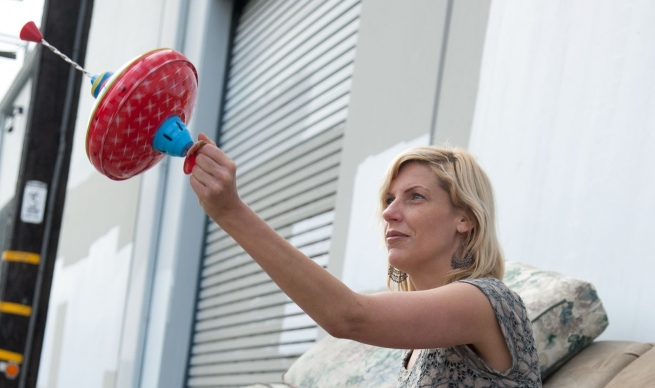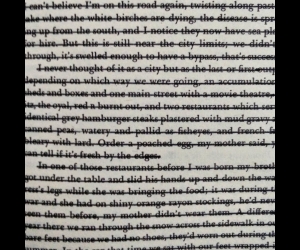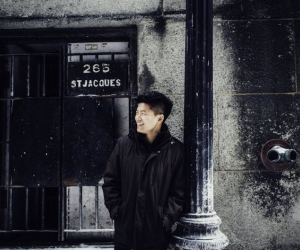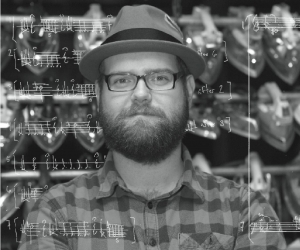
With an underground club DJ’s flair for performance and a conceptual artist’s commitment to the rigorous investigation of ideas, San Diego interdisciplinary artist Margaret Noble explores in her sound work Frakture the resonance in contemporary society of George Orwell’s 1949 dystopian novel Nineteen Eighty-Four. First presented as a solo electronic–acoustic performance at the experimental music series Fresh Sounds in San Diego in 2010, Frakture has since evolved into a recording (now pressed on vinyl) consisting of eight tracks, the first of which, Safer Is Better, won top marks from the jury of Musicworks’ 2013 Electronic Music Composition Contest.
The piece is an audio collage of analog synthesizer, acoustic drums, recordings of health-care protests, contemporary political propaganda, city emergency alarms, the New York Stock Exchange, dice rolling, camera flashes, vinyl record samples, and field recordings of pesticide spraying—all collected during a conceptual investigation that Noble conducted after much in-depth listening to a vinyl record of a 1953 radio-play adaptation of Orwell’s novel. While Noble refers to Frakture as a remix of that record, the work’s points of origin are a series of discussions she had with various people and her own thinking about media literacy—“what you can trust and not trust”—which happened well before everyone was talking about NSA-document-leaker Edward Snowden.
“I began gathering clips and recording sounds that referred directly or symbolically to the various lines of control government has on society, and then started playing around—creating big messes and then adding more,” laughs Noble. Safer Is Better, she says, sets the mood and idea framework of the overall work. “There is humour in the piece, melodies that are ironic, the beating of a drum, the sound of a marching army. I wanted to charge sounds with their own weight. I did a lot of feedback loops inside my mixer, feeding sounds back upon themselves.”
Raised in San Diego, where she received a BA in philosophy from the University of California, Noble made her way to Chicago in the late 1990s. After several active years performing as an electronic-music DJ in the underground-club community, Noble began feeling she had pushed turntables and dance music as far as she could, in terms of making new things. “So I decided to evolve, and went to the School of the Art Institute of Chicago and did a masters in sound art,” she says. “I learned about gear and new toys, and how to experiment with sound in a new way. I make collage now, and when I was DJing I was mixing records with collage.
“I feel like I’m toggling two worlds—the contemporary art scene, which is heavily conceptual, and that of sound art and DJing; and Safer Is Better is like a bridge. I’m exploring contemporary-art-world practices and also designing an experience, which is what DJing is for me.”
In November 2013 Noble participated in a symposium put on by the Carnegie Museum of Art in Pittsburgh, Pennsylvania, called A Collection of Misfits: Time-Based Media and the Museum. “Someone from every major institution was there for discussions about how we deal with archiving this work. There are so many different technologies for performance, so what happens when a playback technology isn’t relevant anymore? Digital media is so intangible, there is no commitment—which is why my strategy was to press vinyl, which people are still collecting and playing today.”
Noble’s artwork has been exhibited across the United States and in Europe, and she has been awarded the International Governor’s Grant, the Hayward Prize, the Microsoft Global Educator Award for Arts and Mathematics, and the Creative Catalyst Fellowship. She called winning first prize in Musicworks’ composition contest “a real honour” in an email communication, which also mentioned that Noble had been in touch with the magazine in 2012 to obtain back issues on instrument construction as reference and inspiration for a public arts project she was working on in San Diego.
“The reality is, I am interested in the audience experience,” Noble says. “There are challenges in presenting sound work in the contemporary-arts-museum model: it’s hard to get a solo room; there is pressure to have visuals; not too many people want to stand for a long time with headphones on. Artists have to spend more time figuring out how to deal with these challenges.”
As for Noble, she’s excited about her latest challenge. “Right now, I’m building a twelve-channel sound studio for the production of surround-sound narrative works for performance and installation. I’m converting the garage.”
Audio: Safer is Better (2010). Composed and performed by Margaret Noble (analog synthesizers, digital samplers, turntables, random objects, and toys). Image: Margaret Noble. Image by: Rebecca Webb.


